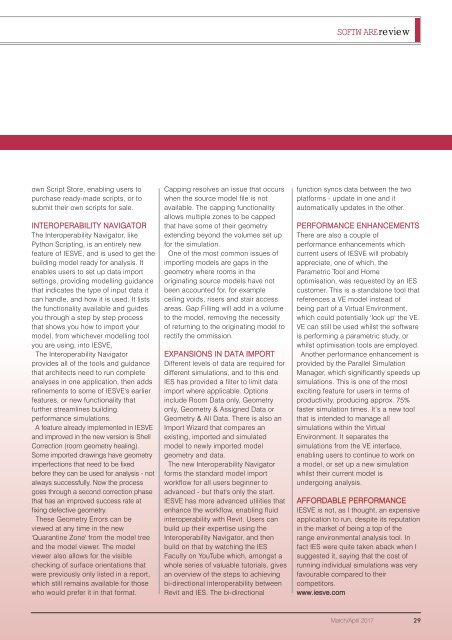CU1703
You also want an ePaper? Increase the reach of your titles
YUMPU automatically turns print PDFs into web optimized ePapers that Google loves.
SOFTWAREreview<br />
own Script Store, enabling users to<br />
purchase ready-made scripts, or to<br />
submit their own scripts for sale.<br />
INTEROPERABILITY NAVIGATOR<br />
The Interoperability Navigator, like<br />
Python Scripting, is an entirely new<br />
feature of IESVE, and is used to get the<br />
building model ready for analysis. It<br />
enables users to set up data import<br />
settings, providing modelling guidance<br />
that indicates the type of input data it<br />
can handle, and how it is used. It lists<br />
the functionality available and guides<br />
you through a step by step process<br />
that shows you how to import your<br />
model, from whichever modelling tool<br />
you are using, into IESVE,<br />
The Interoperability Navigator<br />
provides all of the tools and guidance<br />
that architects need to run complete<br />
analyses in one application, then adds<br />
refinements to some of IESVE's earlier<br />
features, or new functionality that<br />
further streamlines building<br />
performance simulations.<br />
A feature already implemented in IESVE<br />
and improved in the new version is Shell<br />
Correction (room geometry healing).<br />
Some imported drawings have geometry<br />
imperfections that need to be fixed<br />
before they can be used for analysis - not<br />
always successfully. Now the process<br />
goes through a second correction phase<br />
that has an improved success rate at<br />
fixing defective geometry.<br />
These Geometry Errors can be<br />
viewed at any time in the new<br />
'Quarantine Zone' from the model tree<br />
and the model viewer. The model<br />
viewer also allows for the visible<br />
checking of surface orientations that<br />
were previously only listed in a report,<br />
which still remains available for those<br />
who would prefer it in that format.<br />
Capping resolves an issue that occurs<br />
when the source model file is not<br />
available. The capping functionality<br />
allows multiple zones to be capped<br />
that have some of their geometry<br />
extending beyond the volumes set up<br />
for the simulation.<br />
One of the most common issues of<br />
importing models are gaps in the<br />
geometry where rooms in the<br />
originating source models have not<br />
been accounted for, for example<br />
ceiling voids, risers and stair access<br />
areas. Gap Filling will add in a volume<br />
to the model, removing the necessity<br />
of returning to the originating model to<br />
rectify the ommission.<br />
EXPANSIONS IN DATA IMPORT<br />
Different levels of data are required for<br />
different simulations, and to this end<br />
IES has provided a filter to limit data<br />
import where applicable. Options<br />
include Room Data only, Geometry<br />
only, Geometry & Assigned Data or<br />
Geometry & All Data. There is also an<br />
Import Wizard that compares an<br />
existing, imported and simulated<br />
model to newly imported model<br />
geometry and data.<br />
The new Interoperability Navigator<br />
forms the standard model import<br />
workflow for all users beginner to<br />
advanced - but that's only the start.<br />
IESVE has more advanced utilities that<br />
enhance the workflow, enabling fluid<br />
interoperability with Revit. Users can<br />
build up their expertise using the<br />
Interoperability Navigator, and then<br />
build on that by watching the IES<br />
Faculty on YouTube which, amongst a<br />
whole series of valuable tutorials, gives<br />
an overview of the steps to achieving<br />
bi-directional interoperability between<br />
Revit and IES. The bi-directional<br />
function syncs data between the two<br />
platforms - update in one and it<br />
automatically updates in the other.<br />
PERFORMANCE ENHANCEMENTS<br />
There are also a couple of<br />
performance enhancements which<br />
current users of IESVE will probably<br />
appreciate, one of which, the<br />
Parametric Tool and Home<br />
optimisation, was requested by an IES<br />
customer. This is a standalone tool that<br />
references a VE model instead of<br />
being part of a Virtual Environment,<br />
which could potentially 'lock up' the VE.<br />
VE can still be used whilst the software<br />
is performing a parametric study, or<br />
whilst optimisation tools are employed.<br />
Another performance enhancement is<br />
provided by the Parallel Simulation<br />
Manager, which significantly speeds up<br />
simulations. This is one of the most<br />
exciting feature for users in terms of<br />
productivity, producing approx. 75%<br />
faster simulation times. It’s a new tool<br />
that is intended to manage all<br />
simulations within the Virtual<br />
Environment. It separates the<br />
simulations from the VE interface,<br />
enabling users to continue to work on<br />
a model, or set up a new simulation<br />
whilst their current model is<br />
undergoing analysis.<br />
AFFORDABLE PERFORMANCE<br />
IESVE is not, as I thought, an expensive<br />
application to run, despite its reputation<br />
in the market of being a top of the<br />
range environmental analysis tool. In<br />
fact IES were quite taken aback when I<br />
suggested it, saying that the cost of<br />
running individual simulations was very<br />
favourable compared to their<br />
competitors.<br />
www.iesve.com<br />
March/April 2017 29

















